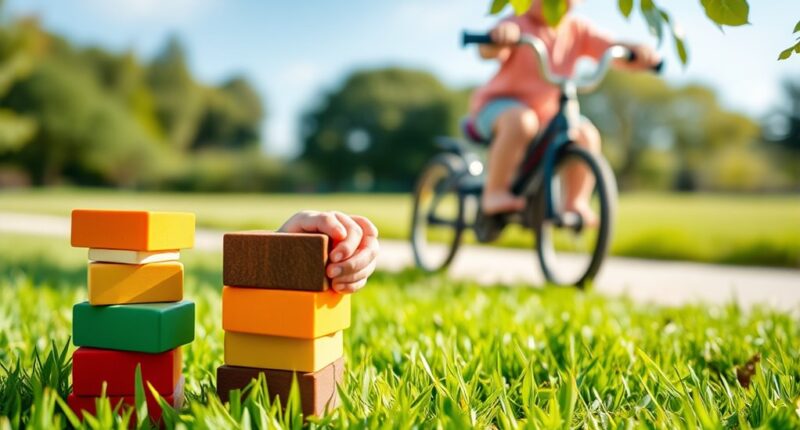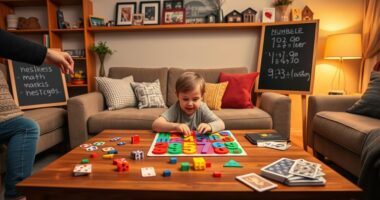Motor skill development is vital for your child’s growth. Fine motor skills, like using scissors or stringing beads, enhance hand coordination, while gross motor skills, such as running and climbing, improve overall physical strength and balance. Engaging in fun activities like playdough or outdoor obstacle courses helps develop these essential skills. As your child masters these activities, they’ll gain confidence and independence. Discover more ways to support their motor skill growth and foster a love for physical activity.
Key Takeaways
- Engaging in playdough activities enhances grip strength and fine motor coordination, essential for tasks like writing.
- Stringing beads or macaroni improves hand-eye coordination, fostering dexterity in fine motor skills.
- Cutting with scissors refines precision and control, vital for developing fine motor skills.
- Outdoor activities like gardening promote fine motor control while encouraging physical engagement and exploration.
- Setting up obstacle courses enhances gross motor skills, agility, and overall coordination through active play.
Understanding Fine and Gross Motor Skills
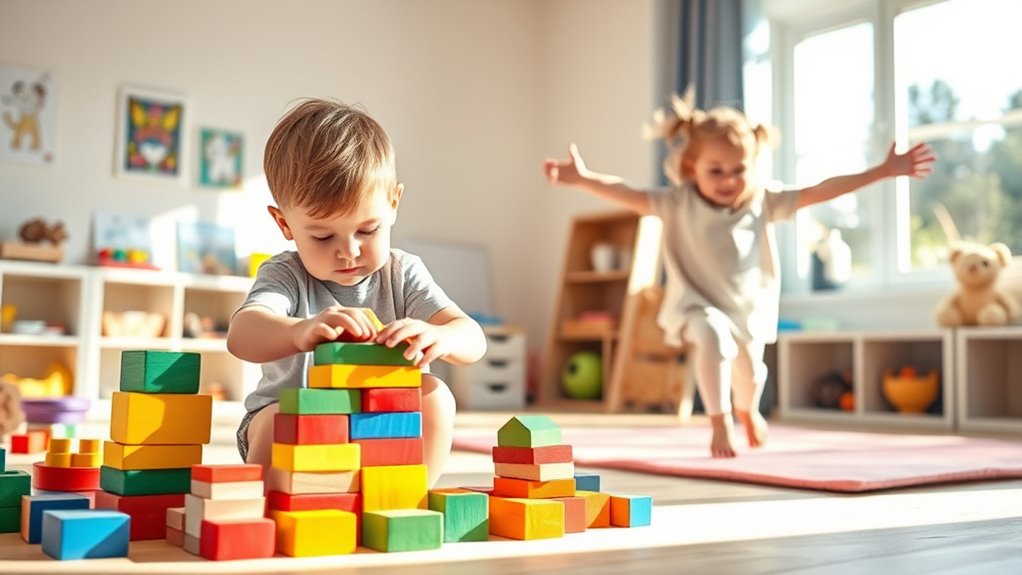
When you think about motor skills, it’s essential to understand the difference between fine and gross motor skills, as both play a significant role in your daily life.
Gross motor skills involve large muscle groups, allowing you to perform movements like walking, running, and jumping. These skills are important for physical activities and overall mobility.
Gross motor skills utilize large muscle groups for fundamental movements such as walking, running, and jumping, essential for mobility and physical activities.
On the other hand, fine motor skills focus on the coordination of smaller muscles in your hands and fingers, enabling precise tasks such as writing, buttoning a shirt, and using scissors.
Both skill sets develop from birth and support your independence in self-care and academic activities. Engaging in targeted activities can enhance both types of motor skills, contributing to your overall development.
Developmental Milestones in Motor Skills

Motor skill development unfolds through various stages, each marked by specific milestones that reflect a child’s growing abilities.
In infancy, you’ll notice your baby tracking objects by one month and reaching for them by two to three months. By six months, they can sit independently and roll both ways. As they reach 11 months, they’ll start standing and taking steps.
Between 12 to 18 months, your child walks alone and begins to climb stairs. By 19 to 24 months, they’ll improve running skills and stack cubes.
In preschool, your child will balance, skip, and catch a ball. Each milestone is essential, showing how they gain control and coordination in their movements as they grow.
The Importance of Motor Skills for Growth
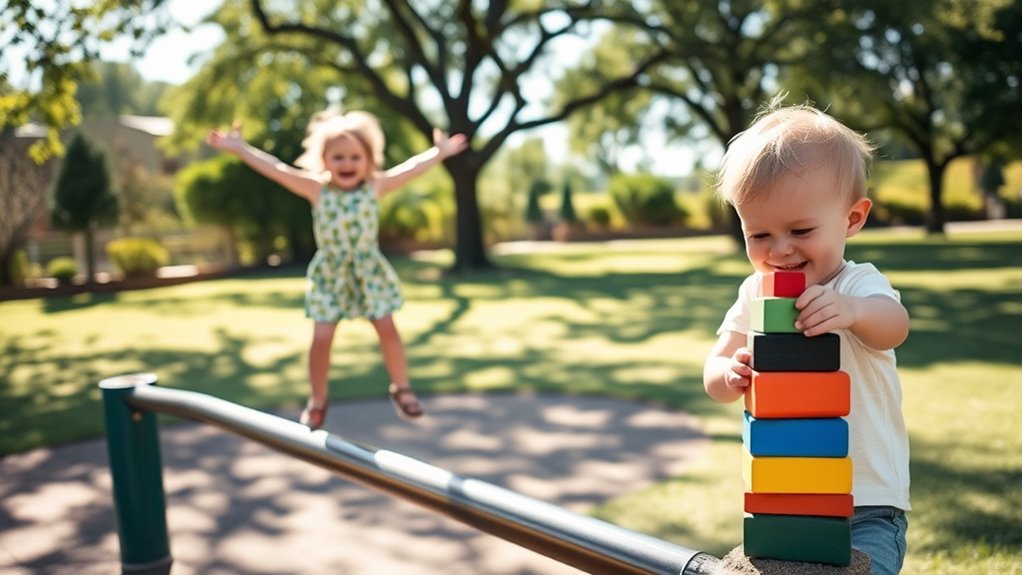
As children reach various motor skill milestones, the importance of these skills for their overall growth becomes increasingly clear.
Motor skills are foundational to physical, cognitive, social, and emotional development. Gross motor skills, like running and climbing, enhance coordination, balance, and even cardiovascular health.
Meanwhile, fine motor skills allow for precise movements essential for tasks like writing and self-care. Mastering these skills fosters independence and builds confidence, influencing self-esteem positively.
Additionally, proficient motor skills correlate with academic success, improving concentration and engagement in school.
Engaging Activities for Fine Motor Skill Development
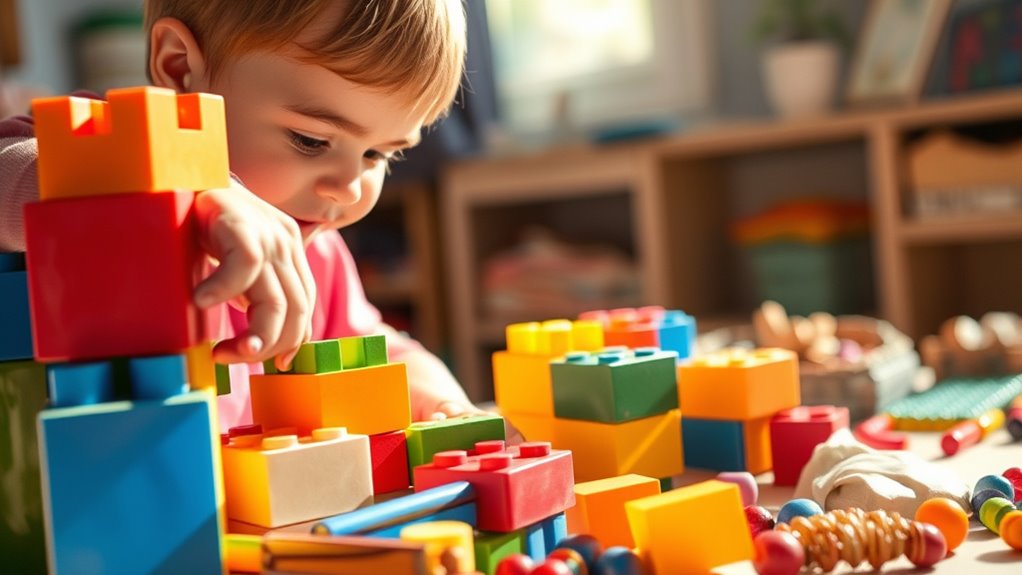
Developing fine motor skills can be both fun and educational, offering children a chance to engage in activities that promote dexterity and coordination.
You can start with playdough, squeezing and rolling it to enhance grip strength. Stringing beads or macaroni improves hand-eye coordination, while cutting with scissors refines precision.
Encourage creativity with markers for drawing and color activities. Sensory play, like using eyedroppers in water, helps develop precise movements.
Foster your child’s creativity and precision through drawing with markers and engaging sensory play with eyedroppers.
Everyday tasks like buttoning shirts and tying shoelaces are practical ways to practice these skills. Outdoor activities, such as gardening or scavenger hunts, also promote fine motor control.
These engaging activities won’t only refine motor skills but also provide joy and learning opportunities for your child.
Fun Ways to Enhance Gross Motor Skills

Fine motor skills are just one part of a child’s physical development; gross motor skills play an essential role in their overall growth and coordination. gross motor skills are developed through critical periods in early childhood when children are particularly receptive to learning new physical abilities.
You can enhance these skills through fun activities. Set up obstacle courses to improve running agility, or encourage climbing and balancing on playground structures. Ball games like catch boost hand-eye coordination. Riding bikes or scooters promotes balance and physical activity.
Try innovative games like hopscotch variations or chalk Twister for added excitement. Indoor activities like mini-trampoline jumping or hula hoop challenges are also effective.
Don’t forget movement stations in educational settings or short active breaks during lessons to keep kids engaged. These activities not only develop skills but also make movement enjoyable! Additionally, fostering a supportive community can help children stay motivated and engaged in their physical development.
Assessment Tools for Motor Skill Competence

When evaluating motor skill competence in children, it’s crucial to choose the right tools that cater to various skill domains and age groups.
The Bruininks-Oseretsky Test of Motor Proficiency-2 (BOT-2) is excellent for thorough assessments but requires more equipment.
For object control skills, the Test of Gross Motor Development (TGMD) stands out, while the Movement Assessment Battery for Children-2 (M-ABC-2) is easy to administer, though less sensitive.
Preschoolers benefit from the Motoriktest für Vier- bis Sechjärige Kinder (MOT 4–6), which focuses on both gross and fine motor skills.
If balance is a priority, the Körperkoordinations Test für Kinder (KTK) is ideal.
Consider age, equipment needs, and cultural relevance when selecting the best assessment tool for your context.
The Long-Term Impact of Motor Skills on Health and Well-Being
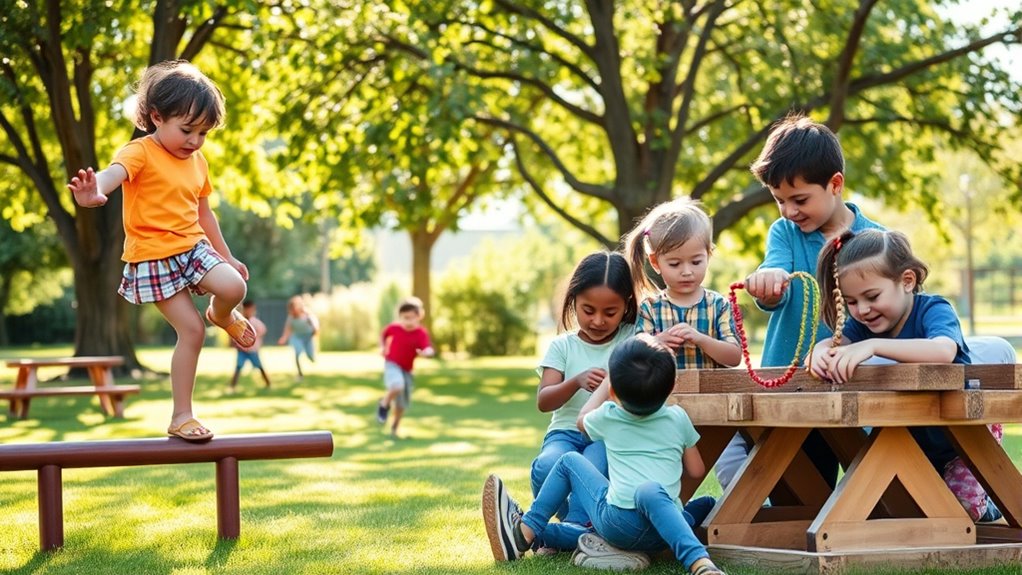
While many people focus on the immediate benefits of motor skill development, its long-term impact on health and well-being is equally significant.
Developing motor skills enhances cognitive functions like attention and memory, making you more efficient in problem-solving. This is especially true for children with cognitive impairments, who show remarkable improvements in executive function.
Enhancing motor skills significantly boosts cognitive functions, particularly in children with impairments, leading to improved problem-solving abilities.
Proficient motor skills also lead to better physical health—contributing to endurance, muscle strength, and a reduced risk of diseases.
Socially, engaging in motor activities fosters interactions and boosts self-esteem. Over time, strong motor skills encourage lifelong participation in physical activities, promoting a more active lifestyle.
Ultimately, the long-term benefits of motor skills extend well beyond childhood, shaping your overall health and well-being.
Frequently Asked Questions
What Age Should My Child Start Developing Motor Skills?
Your child starts developing motor skills right from birth.
In the first few months, you’ll notice them pushing up during tummy time and grasping toys.
By six months, they’ll likely sit independently and roll over.
As they approach their first birthday, expect them to crawl and pull up to stand.
These early milestones are essential, laying the foundation for more advanced skills like walking, running, and jumping in the years to come.
How Can I Encourage My Child to Practice Motor Skills at Home?
To encourage your child to practice motor skills at home, make it fun and engaging. Incorporate activities like drawing, crafting, or playing with playdough into their daily routine.
Create obstacle courses or set up active games that involve running and jumping. You can also involve them in mealtime tasks, like setting the table or pouring drinks.
Consistent, playful practice will help them develop essential skills while enjoying their time with you.
Are There Specific Toys That Promote Motor Skill Development?
Are you looking for toys that can really boost your child’s motor skills? You’ll find that stacking toys, building blocks, and lacing beads work wonders for fine motor skills.
For gross motor skills, consider ride-on toys, climbing sets, and balls. These toys not only engage your child in fun activities but also promote coordination, strength, and confidence.
Choosing the right toys can make a big difference in their development!
How Do Motor Skills Affect Social Interactions in Children?
Motor skills play an essential role in shaping your child’s social interactions. When they master physical activities, they gain confidence, making it easier to connect with peers.
As they engage in play, those motor skills help them navigate social situations, enhancing communication and cooperation. You’ll notice they participate more actively, fostering friendships and emotional well-being.
Encouraging their motor development ultimately lays a strong foundation for social skills, benefiting their overall growth.
What Signs Indicate a Delay in My Child’s Motor Skill Development?
You might notice signs of motor skill delays in your child if they struggle with grasping or releasing objects, show poor hand-eye coordination, or seem clumsy.
If they’ve trouble with tasks like writing or using utensils, it could be a concern.
Additionally, watch out for difficulties in rolling over, walking, or maintaining balance.
If you see these signs, consulting a pediatrician for early intervention is essential for your child’s development.
Conclusion
In nurturing your child’s motor skills, you’re not just helping them master simple tasks; you’re laying the groundwork for a lifetime of confidence and independence. Each wiggle, grasp, and leap is a stepping stone toward their future. So, embrace those messy art projects and wild playdates—these moments are crafting more than just muscles; they’re shaping resilient spirits. By investing time in their development, you’re gifting them the ability to navigate the world with ease and grace.
